|
|

|
Green Fuse Grove (Green Fuse, Hem Genetics, Schoneveld, Beekenkamp, Westhoff)
Santa Barbara Polo Club (Pacific Plug & Liner, PlantHaven, Plant Development Services, Inc., Suntory)
|
 |
 |
A trip to Green Fuse Grove
Chris: This is your Day 2 coverage of the 2025 California Spring Trials—aka CAST—wherein my sidekick and Tech on Demand Editor Bill Calkins and I write about the highlights from the day’s visits, aided and abetted by GrowerTalks editor Jen Zurko and videographer extraordinaire Osvaldo Cuevas. Two stops today and nine different breeders to discuss, so we we'll cut out any excess banter and get right to it with stop 1, Green Fuse Grove, full-time home of Green Fuse Botanicals and part-time home of Beekenkamp, Schoneveld, Westhoff and Hem. Bill, start us off with our host, Green Fuse ...
Bill: Owner Steve Jones is so good at explaining exactly why he and the Green Fuse team breed the crops they introduce and a prime example is the new Uprising series of thunbergia. While existing thunbergia tend to be grown and sold by retail growers due to the plant’s size and vining habit (i.e. they’re difficult to ship), the new Uprising series is extremely responsive to PGRs and can be produced and shipped in gallons. The key is that they'll grow out of the PGR effects in only three or four weeks—and then they take off and vine as expected. The series launches with six colors, including some really nice eyes and a pure white with eye.
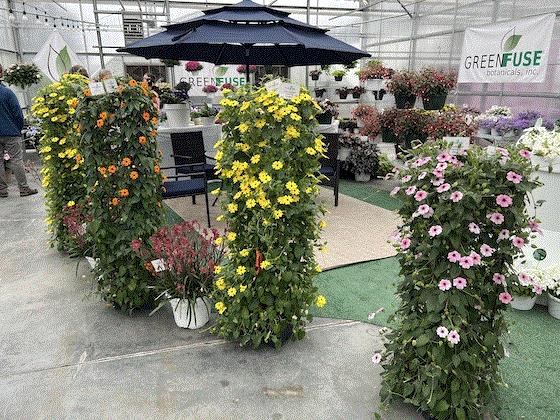
Chris: I like when I can write about crops I’ve grown professionally—in this case, fuchsia and streptocarpus. The Windchimes Basket collection gets two colors: Double Rose Violet and Red Vein. Double Rose Violet is the first large-flowered double for Green Fuse. And it happens to carry the same color pattern as that venerable old variety Swingtime (which I used to grow 40 years ago). And as Red & White is their best seller, Windchimes Basket Red Vein should do well. The “vein” in the name indicates a red vein in the foliage.
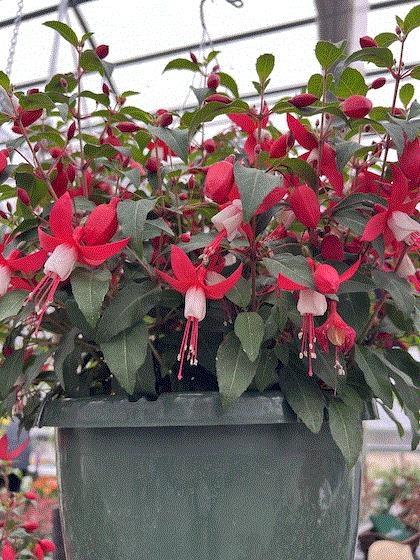
As for Streptocarpus, another crop I grew for my florist customers, their Ladyslippers collection gets its first double-flowered varieties: Double Midnight and Double Blue Ice. Very pretty!
Bill: I’ve liked the Green Fuse Gamechanger Hydrangeas since we first saw them as concepts a few years ago. They’re the result of top-secret interspecific breeding, and the “game-changing” story is that they can be produced without vernalization and are daylength neutral. For some of the same reasons first-year flowering perennials have taken off in recent years, these hydrangeas are poised to change the game for many growers who’ve traditionally stayed away from woody ornamental types. With a pinch at six weeks, a nice “prefinished” hydrangea is ready in as little as eight or 14 weeks, depending how large you want them and can be easily bumped up into larger pots. New for 2026 are Pink Burst (with H. macrophylla-like flowers) and Freely Blue (a lacecap-style flower).
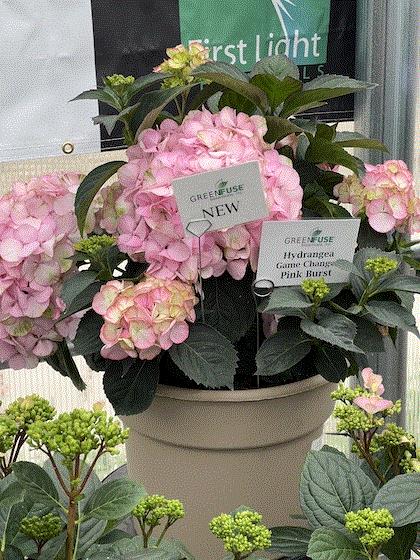
Chris: You saved me a great southern annual, Bill—Pentas Phenom. This is vegetative, not seed, and Steve said they’ll be concentrating on traits you can’t find in seed pentas—namely star patterns and double flowers. To that end, they introduced four new ones: Star Red and Star Lavender, and Double Pink and Double White. This is one we’ll need to test in the heat to see how it performs compared to existing varieties.
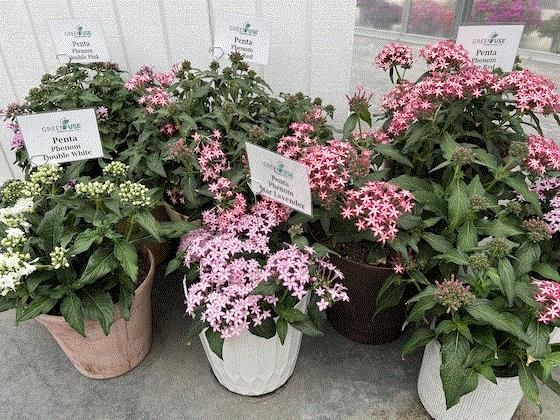
See all these and much more in our GREEN FUSE VIDEO. So, Bill, what’s new from Dutch breeder Beekenkamp?
Beekenkamp dahlias, pericallis and more
Bill: Two years ago, we saw the vast assortment of Beekenkamp dahlias displayed series by series and habit by habit. That presentation really helped us understand the positioning of their dahlia series, so when we spotted a Labella Grande sign this year, we already knew they’d be for 6-in. pots and finish quick (14 weeks) from URC. But what was new and unexpected was the deep, dark foliage that's the mark of the Labella Grande Chocolate subseries. The foliage contrasts nicely with the double flowers in Amber, Rose, Red and Apricot. We all really loved them. Oh, one Tech Tip: High light triggers the darkening of the foliage.
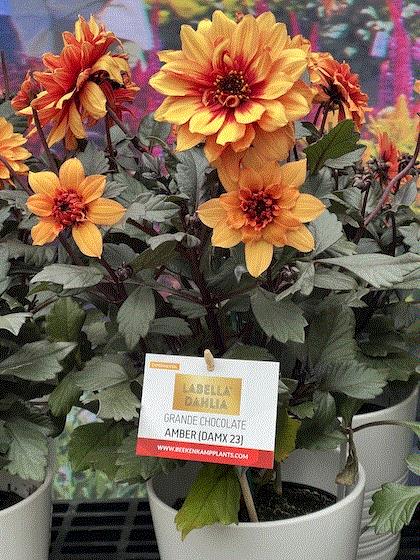
Chris: Here’s a new series that popped: the Pop! Series of pericallis (aka cineraria). From their own breeding, Pop! are selected for excellent rooting—upwards of 95% to 98% take, they say, which is excellent and opens the class up to more rooting stations and growers. They're naturally compact and require no pinching. And they’ll hold up to a cold (55F) growing regime, if you want to save money in winter when you’re producing them for early spring sales. The series has seven colors.
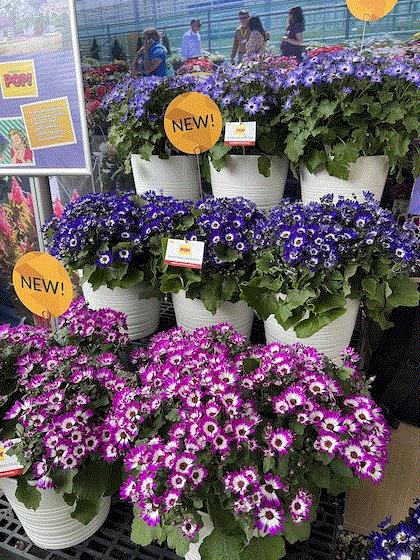
Bill: How about some more verbena, boss? We’ve already seen a couple new verbena series in Cali and it’s only day two! Beekenkamp introduced their own breeding in the class with a series called Fuerte, which includes two distinct sizes/habits, both with strong powdery mildew resistance and weather tolerance. Denso is the more compact collection and includes three colors, while Blancos are semi-trailing and are available in eight colors.
 Two new blue cyclamen from Schoneveld
Chris: Another Dutch breeder was displaying at Green Fuse Grove—Schoneveld, best known for cyclamen (although they have much more than that). Just one new one to show us this year ... but it is a breakthrough! Possibly one of the biggest we'll see at CAST this year (although we’ve got three days left and anything is possible): It’s the world’s first BLUE cyclamen, named Dragon!
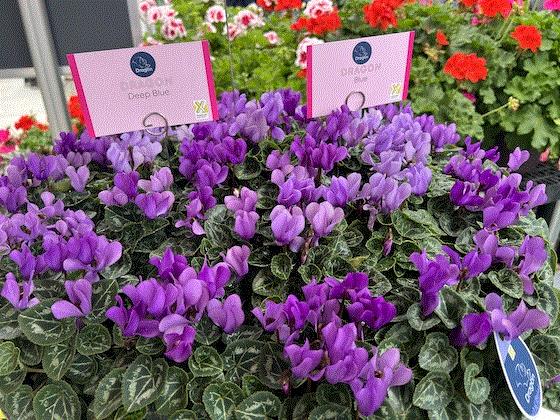
Now, admittedly, Schoneveld calls the two shades of blue “horticultural blue,” which means it leans toward purple or lavender. Still, Dragon is the closest thing we have to a blue cyclamen. There are two shades, Deep Blue and Blue ... you can get them singly or as a mix. Dragon is a mini for up to 4-in. pots; we hope we’ll see the color in larger pots. Oh, the Dragon name is a nod to Japan, where the variety was bred.
Now, Bill, on to Germany (well, a German breeder) and Westhoff.
The Westhoff disco
Bill: At the Westhoff trial, we always expect to see wild new petunias and this year did not disappoint. I’ll start by mentioning that they’ve dropped 10 of their older Crazytunias—the time came for the innovative breeder to dial in the assortment and match their habits to help growers send more uniform, compact assortments to retail (a shipping rack of plants was proof of that). But to make up for the loss, they introduced four new Crazys for 2026 that are all quite unique. My favorite is Yello, a super-strong yellow with a faint hint of green. It joins the descriptively named Blackberry Syrup, Bananarama and Ink Blot.
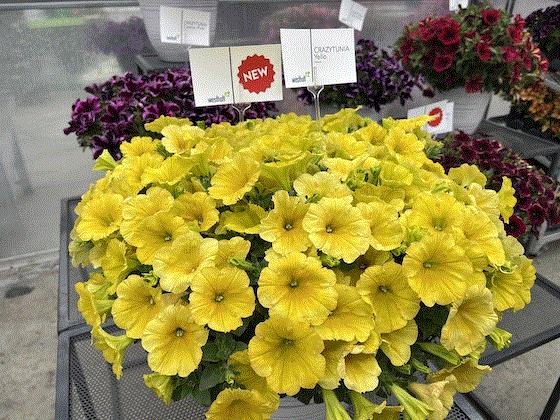
In name-change news, Westhoff had a collection of vivid red and orange petunias called Hells. Maybe because it was a bit controversial they've renamed that group Inferno and they've added a really unique Metallic Orange (with orange and magenta flowers) and another one called simply, The Orange!, meaning, we think, that it doesn’t get any more orange than that. It joins The Red!, introduced last year.
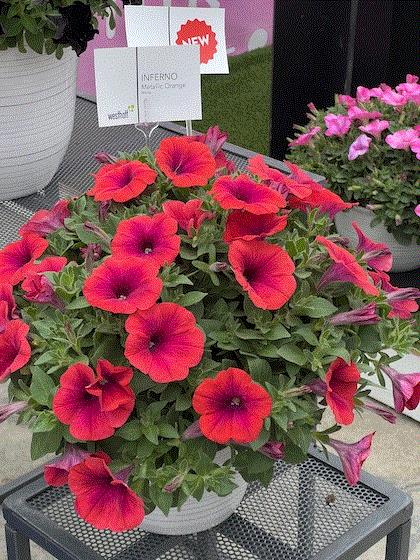
Before I toss it over to you, Chris, I want to call out another Westhoff petunia, a new standalone named Pink Cloud. It’s a really beautiful two-toned soft pink with huge blooms. We were told it cycles into flower about twice as quickly as other petunias, so it’s always in bloom, with no bare spots.
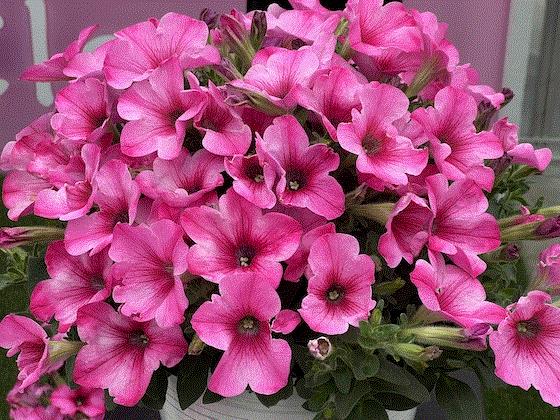
Chris: That’s a lot of petunias! But Westhoff has more, including two new verbena series, Peekaboo and Muffin. Peekaboo features a semi-upright habit and bright white eyes on all six colors (hence the name), while Muffin is a compact little muffin-top mound of a plant, needing no PGRs. It offers four colors.
Bill: Lastly, a combo program … a grower-friendly collection called E-Z Mix brings two different bicolor and color-changing varieties together, resulting in combos that have really cool color patterns that appear as though there are more than just two varieties in the pot. You can order your favorite by name and they’ll package the appropriate cuttings for you.
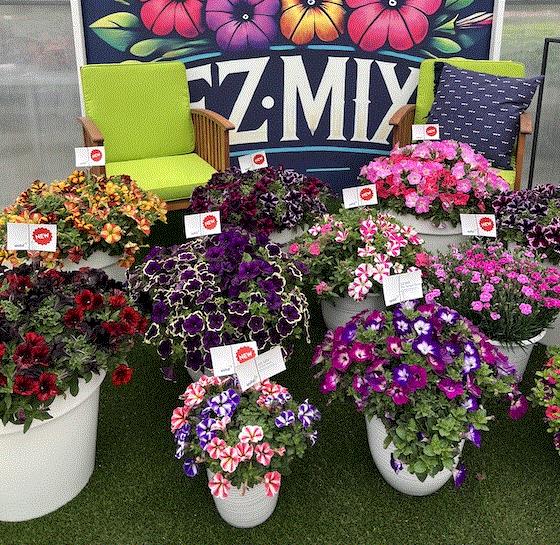
It’s hard to describe in writing all the colors and patterns Westhoff packs into their varieties, so your best bet is to WATCH THE VIDEO. When it ends, follow us over to Hem to see a couple of new dianthus and two new tomatoes.
 Hem’s new flowers and edibles
Chris: Dutch breeder Hem is known for breeding naturally compact seed annuals and perennials. This year, they were touting dianthus. Divinity is a new D. chinensis series that has that no-PGR-needed compactness they’re known for. It’s like their Diana series, but more compact. Divinity offers seven colors. And Dianthus Supra is an existing perennial (Zone 6) interspecific dianthus series that gets some new Picotee colors: Pink Picotee, Scarlet Picotee and Cherry Picotee.
Bill: After all these years covering trials in California, you all know I like snacks. That’s why I’m glad to have the chance to write about two new series of plum tomatoes from Hem. First up is a taller (but still small for patio pots) series called Plumbrella, which grows to about 16 in. and produces as many as 50 to 60 tomatoes per plant. There are four colors of fruit in the new series—Rosy Pink, Creamy Yellow, Red and Orange.
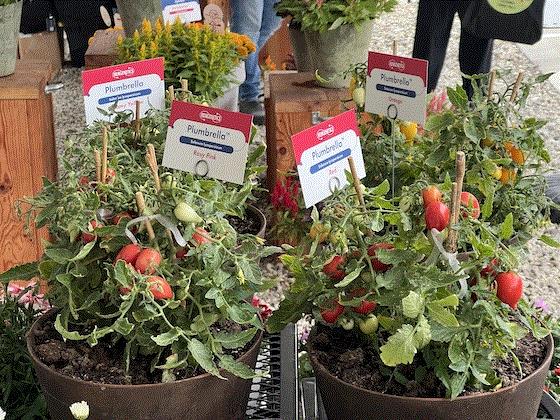
The same four tomato colors are available on even shorter plants in Hem’s new Funnyplums series that stay around 10 in. tall. Check out the tomatoes and dianthus in OUR VIDEO.
Playing polo with PlantHaven
Chris: After wrapping up the Green Fuse Grove trials, we drove north about 45 minutes to the Santa Barbara Polo Grounds & Racket Club, the luxurious (well, it’s a big field of very nice turf) home of several breeders and plant introducers, one of which is PlantHaven, which represents a wide range of quirky and unique genetics from equally quirky and unique breeders. Like this Sahara Euphorbia called Tiny Treasure, which has “fresh, zesty” chartreuse foliage, as they put it. This “spurge,” as it’s known, is Zone-6 tolerant ... probably even Zone 5, they say. And it’s tough and drought tolerant, too.
Bill: PlantHaven does have a unique range of plants and I was wondering what would catch my eye this year, and I have to say the new Mystic Wizard Dahlia was the one. Stunning magenta blooms on dark foliage really jumped out at me, and when I heard some of the best West Coast IGCs are already looking at this variety for fall sales alongside mums, I wasn’t surprised at all.
Chris: I’ll wrap up with Plant Project Manager Amanda Flint’s favorite, PlantHaven’s new dianthus, which comes from well-known breeder Pinks by Whetman. Orange Meringue is part of their single-flowered American Pie collection, featuring big single flowers; while Lemon Sparkler and Orange Sparkler are part of the double-flowered Scent First collection. They’re all Zone-5 hardy, colorful and the doubles are nicely fragrant.
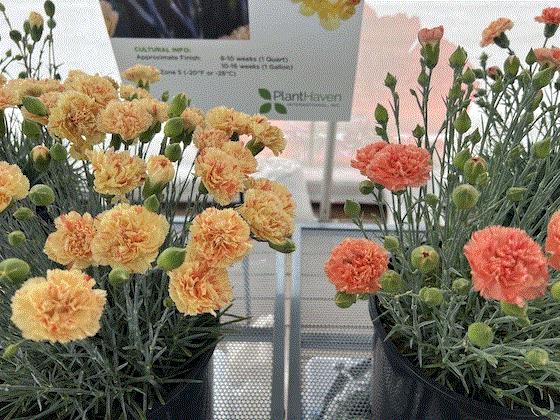
We’ve got them all for you in glorious Technicolor video HERE!
Show us something from Pacific Plug & Liner, Bill ...
 Pacific Plug & Liner rocks out—'80s style
Bill: Much like PlantHaven, Pacific Plug & Liner has a wide range and always sets up some of the most fun themed displays of the entire trials. This year April Herring dreamed up “PP<V”—a takeoff on MTV with an ’80s music theme. Jen and I love the music of that era, so we were all in on this one. Chris, what were you up to in the 80s?
Chris: While you kids were in middle school, I was getting my Florida greenhouse business off the ground, so I had no time to listen to music! But I do now and I dig most of it ... just like I dig all the lavender PP&L offers. Including their newest, Voltage Violet, an L. stoechas type (Spanish) with gray foliage and dusky violet flowers. Now, Voltage Violet is not quite as vivid in color as the varieties flanking it, but April explained that the variety more than makes up for it in its toughness in the landscape. Hardy in Zones 7 to 9.
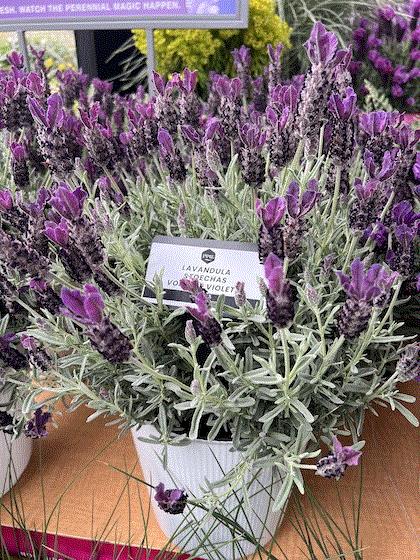
Bill: As with lavender, PP&L is big on hellebores and this year they showed Cherisa, part of the Frostkiss collection. Cherisa is bred to be later blooming than other hellebores for key retail timing. Cherisa’s flowers open yellow to green and mature to burgundy, with excellent branching and a vigorous habit.
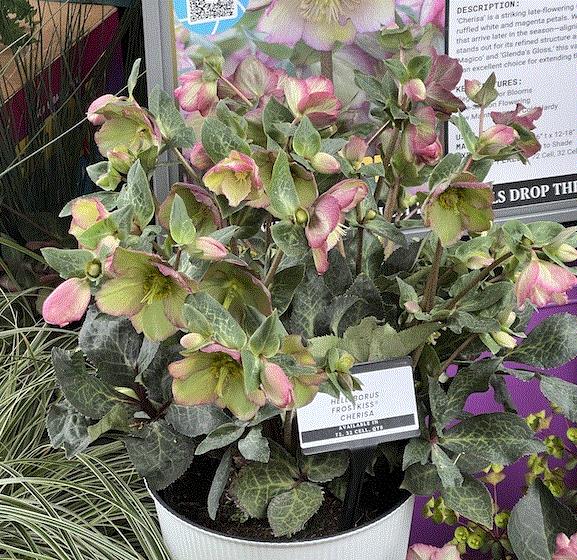
Another hellebore message from PP&L is a prefinished quart-size program that allows growers to either bump them up to a larger size or grow them on as is and sell the quarts in flower.
Chris: Lastly, a euphorbia that would go nicely with the chartreuse one from PlantHaven: Euphorbia Miner’s Berry Bordeaux, with deep red foliage that goes almost black in the summer, then rosy-pink in the fall. It’s very hardy (Zones 4 to 8).
Bill: As we were leaving the PP&L trial tent, we had the opportunity to meet Sofia Arano, the grower responsible for all the trial plant material. She approached us as a “fan” of our coverage, but I’ll speak for our group that the pleasure was ours! As I mentioned yesterday, the teams who work tirelessly to grow and display plants for CAST are the real rockstars of the event!
Chris, kick off our next stop at the Polo Ground trials, Suntory ...
A blast from the past at Suntory
Chris: Suntory is a veteran spring trials exhibitor, going way back to the late ’90s, I think, when the cutting trend was kicking off, and they haven’t stopped introducing cool new varieties. Like all the dipladenia they offer in the Sun Parasol and Sundenia lines. These spectacular tropicals are all the rage for patio planters. New varieties include Sundenia Suprema Vivid Pink, a big showy vining variety; Sun Parasol FiredUp Coral, an upright-growing, non-vining variety that joins FiredUp Orange; and Sun Parasol Original XP Pink, an upgrade from the original that's brighter in color and earlier to flower.
Bill: Also new and cool from Suntory was a Surfinia, Heavenly Cashmere Pink. The Heavenly varieties were top sellers in the series so breeding moved in that direction and Cashmere Pink is a really nice soft color with all of the attributes that make Surfinias favorites of growers and consumers.
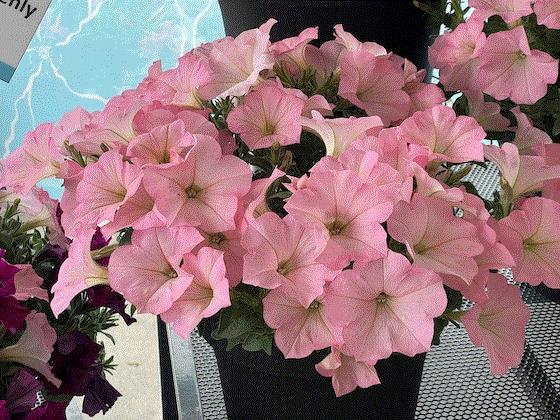
Getting a complete overhaul for 2026, the Bidens Bee Dance series has been improved for a better, mounding habit and much larger flowers. The newest color is Painted Orange, which joins Painted Red Improved and Yellow Improved.
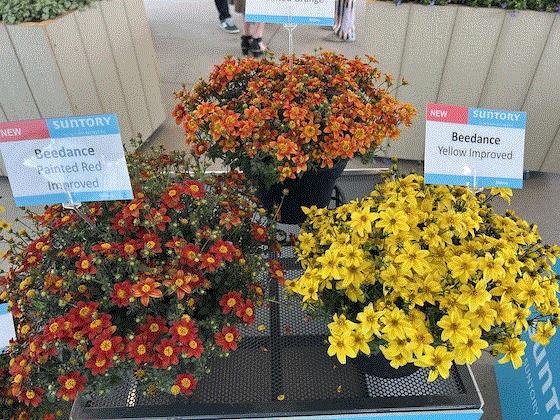
Chris: Lastly from Suntory, one of my wife’s favorites is the Catharanthus (Vinca) Soiree Flamenco collection. Soiree gets three new ones: Strawberry Picotee, Electric Salmon Eye and Plum Velvet. All the Flamencos feature ruffled flowers.
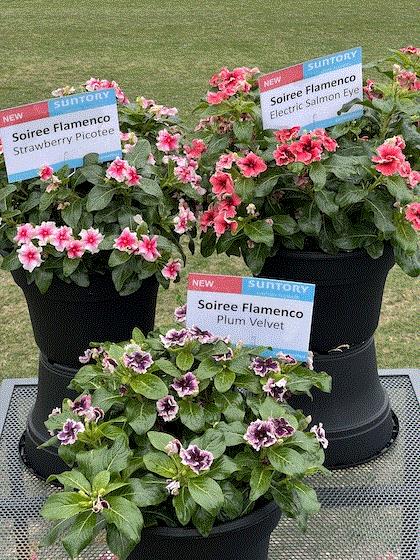
See these Soirees and everything else in THIS VIDEO.
Bill, take us to the last trial of the Polo Grounds stop, Plant Development Services, Inc. (aka PDSI) ...
 New for the Sunset & Southern Living plant collections
Bill: A lot of Southern Living Plant lovers probably know Holly Sky Pencil, an upright green holly that grows up to 8-ft. tall and is hardy from Zones 5 to 9. Now, there’s Golden Sky, with the same habit, but with flushes of bright yellow foliage emerging from the green in bright sunlight. It’s pretty striking and I can see it as a cool hedge or screen.
Chris: It’s fun when we see a variety so new it’s not yet named, which is the case with a pretty Australian native called grevillea, aka spider flower. It resembles a spreading pine with funky red spider-like flowers. And while an Aussie native, this one was bred in California.
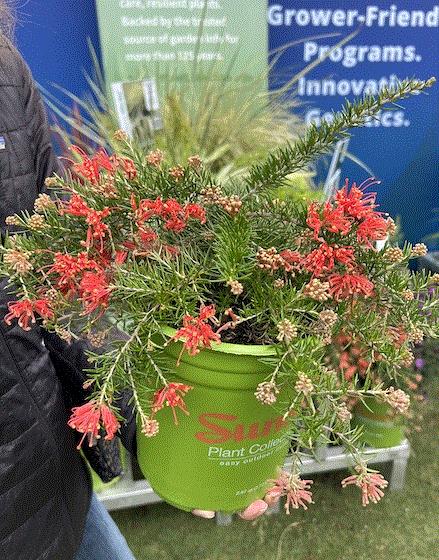
Also new—but named—is Nandina Red Light, which starts reddish pink and matures to pinkish white. Plants are compact, but full, and it’s hardy from Zones 6 to 10.
Bill: Last, but not least, at PDSI is one for the Southern Living collection—a mahonia named Silver Caress. I’m not too familiar with this species, but the relatively soft silver foliage was really interesting and when I heard there are yellow flowers that bloom in January and February, I was bummed to learn it’s Zone 7 hardy so it won’t be in my Cleveland garden. But, Chris, you can definitely have this one, right?
Chris: I could give it a try ... it said Zone 9 and I’m just touching Zone 10 ... but if it doesn’t work, I’ll take all the agapanthus they’ll send me!
Check out PDSI's new intros in THIS VIDEO.
Day 2 is a wrap
Chris: Anyway, a full day as always, but we’re not done yet—we’ve got three more days of trials to cover! Tomorrow (Thursday) is the big Dümmen Orange trial, then the two-hour drive north to Sakata, so fewer trials overall, but more windshield time. Then we spend the remaining two days in the Gilroy area. Stay tuned! Oh, speaking of which—Bill, remind the folks how to follow our antics on social media.
Bill: Oh yeah, be sure to follow us on INSTAGRAM (I’ve posted more than 100 plant pics already) and FACEBOOK to see tons more photos and subscribe to the GROWERTALKS YOUTUBE CHANNEL so you don’t miss any of our fun and informative videos from each and every CAST trial stop! Yesterday’s videos have almost 1,000 views already—all the cool kids are doing it.
NOTE: Here's a link to the FINAL VIDEO from Day 1—Morel cyclamen.
See you tomorrow!
Chris, Jen, Bill & Osvaldo
Chris Beytes
Editor-in-Chief
GrowerTalks/Green Profit
Jen Zurko
Editor
GrowerTalks/Green Profit
Bill Calkins
Senior Editor/Digital Editor
GrowerTalks/Green Profit
Osvaldo Cuevas
Video Producer
GrowerTalks/Green Profit
This email received by 31,751 lucky folks, and you're one of them!
Want to be one of the lucky sponsors who reach those 31,751 readers of Acres of Buzz from Spring Trials? Drop Paul Black a line and he'll tell you what a bargain it is!
|